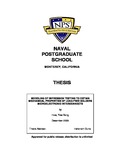Dynamic response of soldered electronic components under impact loading
| dc.contributor.advisor | Kwon, Young W. | |
| dc.contributor.advisor | Didoszak, Jarema M. | |
| dc.contributor.author | Wood, Andrew Calvin | |
| dc.date | December 2011 | |
| dc.date.accessioned | 2012-08-22T15:33:22Z | |
| dc.date.available | 2012-08-22T15:33:22Z | |
| dc.date.issued | 2011-12 | |
| dc.identifier.uri | https://hdl.handle.net/10945/10714 | |
| dc.description.abstract | The objective of this research was to analyze the effects of impact loading on electronic component failure. A standard fiberglass composite printed circuit board (PCB) card was used in two impact tests. The first test consisted of a PCB card with four adhered strain gauges, which were mounted inside an aluminum box fabricated for testing. Impact testing was conducted with weights ranging from 0 to 30 lb., and the corresponding strain values were recorded. For the second set of impact tests, a new circuit card was mounted inside the aluminum box. The new circuit card maintained the same dimensions, but no strain gauges were attached. Solder joints were placed at nine different locations on the card, and testing was conducted to determine the impact load at solder joint failure. Both visual and resistance inspections were conducted after each impact. After seven drop tests were conducted, no failure had been detected. This lack of failure was attributed to the rigidity and substantial nature of the aluminum box used in testing. Upon completion of both impact tests, two Finite Element Method (FEM) models were built. The first FEM model represented a scaled version of the PCB card, four solder joints, and a silicon computer chip. Strain data from the PCB card testing was input into the model, and a corresponding solder joint strain was calculated. The second FEM model was a full-scale version of the aluminum box and mounted circuit card. A force was applied to the box, and the various stains were recorded on the PCB card. The collection of this data has helped to establish a valuable relationship between the strains in PCB cards and solder joints, and it will increase the understanding of electronic component failure under impact loading conditions. | en_US |
| dc.description.uri | http://archive.org/details/dynamicresponseo1094510714 | |
| dc.format.extent | xvi, 63 p. : col. ill. ; 28 cm. | en_US |
| dc.publisher | Monterey, California. Naval Postgraduate School | en_US |
| dc.rights | This publication is a work of the U.S. Government as defined in Title 17, United States Code, Section 101. Copyright protection is not available for this work in the United States. | en_US |
| dc.subject.lcsh | Finite element method. | en_US |
| dc.title | Dynamic response of soldered electronic components under impact loading | en_US |
| dc.contributor.department | Mechanical and Aerospace Engineering (MAE) | |
| dc.subject.author | Author subject terms:; | en_US |
| dc.description.service | US Navy (USN) author | en_US |
| etd.thesisdegree.name | M.S. in Mechanical Engineering | en_US |
| etd.thesisdegree.level | Masters | en_US |
| etd.thesisdegree.discipline | Mechanical Engineering | en_US |
| etd.thesisdegree.grantor | Naval Postgraduate School (U.S.) | en_US |
Files in this item
This item appears in the following Collection(s)
-
1. Thesis and Dissertation Collection, all items
Publicly releasable NPS Theses, Dissertations, MBA Professional Reports, Joint Applied Projects, Systems Engineering Project Reports and other NPS degree-earning written works.





